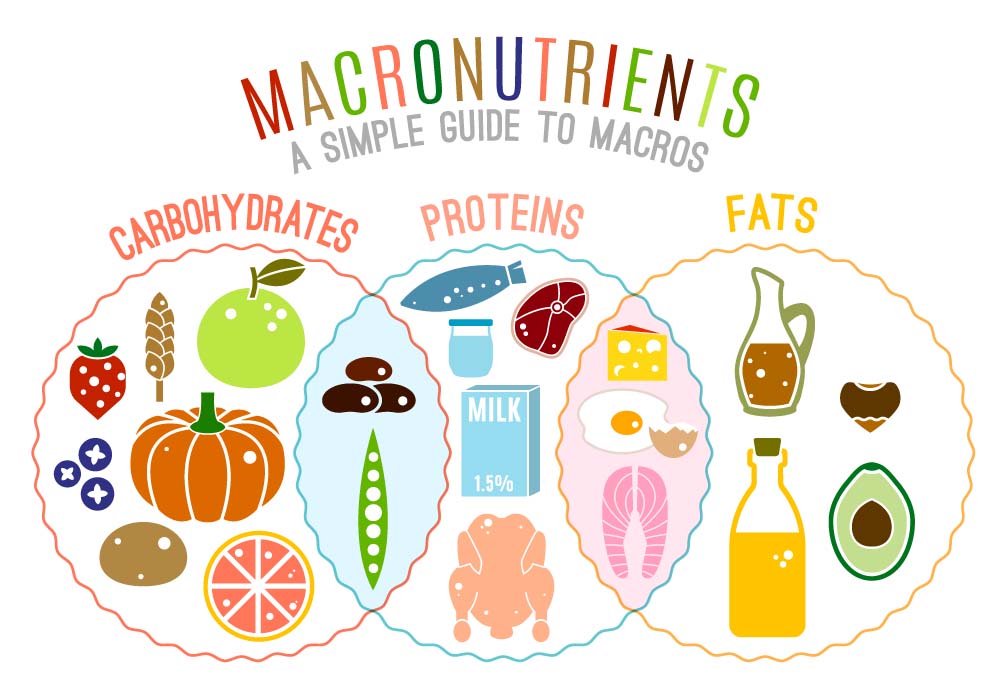When it comes to tracking your diet, counting calories is a common approach. But what we don’t track are nutrients. We are what we eat, and if we’re not fuelling ourselves correctly, how can we expect our bodies to react and look the way we want them to? To achieve results and a balanced diet, providing your body with variety of nutrients that give your body energy and help your digestive system is important. Renuka Dhillon, food scientist and nutritionist, believes that this approach helps you reach your health goals faster than focusing on calories alone. “Calculated intake of food is becoming normal and it is leading to a diet-focused fitness movement and a key player in this movement is macros.”
What Are Macros, Or Macronutrients?

Macros, or macronutrients, are food that provide the body with energy. The three macronutrients that we consume include protein, fat, and carbohydrate. According to the food scientist, contrary to popular belief and fad diets, an average human being needs all three macros. “Cutting out any one macronutrient puts you at risk for nutrient deficiencies and illness.”
• Protein: The body needs proteins for the building and repair of tissues, cellular communication, enzymatic reactions, immune function, and more.
• Fat: Fat helps a person’s body store energy. It also protects the nerves, regulates hormones, aids in nutrient absorption, and maintains body temperature.
• Carbohydrate: Carbohydrates, or carbs, are made up of sugar, starch, and fiber. They are the body’s main source of energy.
Micronutrients, in contrast, is required in much smaller amounts, such as vitamins, minerals and electrolytes.
What Is A Macro Diet

A Macro Diet is usually followed by people looking to shed weight or gain muscle mass. Tracking macros over calories help you understand which types of food make you feel good or bad, which foods improve your physical routine and which foods help you focus or make you dull. Macro dieting is commonly referred to as “flexible dieting”. Counting macros can also help you alter your current eating habits to healthier patterns for the long-term. Dhillon says, “Majority of my clients come to me with the idea of giving up carbs and fat. These popular diets aren’t focused on getting all the nutrients in every meal and snack. People wake up and have a granola bar and a fruit for breakfast and think they have achieved something great. What they don’t realise is without fat and protein in that breakfast, they are just going to be starving in an hour and begin to feel tired before lunch time. Including macronutrients but counting them at the same time can help you reach various health goals.” Dhillon explains, “In the world of nutrition, IIFYM or If It Fits Your Macros means you can eat it as long as it fits into your macros. Can you indulge in a brownie every once in a while and still see success? Yes, technically there are no cheat foods when you’re counting macros, it just means you have to move some macros around to make it fit. Every person is different, and as such, every person's preferable macronutrient intake will be different.”
Benefits Of A Macro Diet

1. Meeting weight loss goals
2. Building lean muscle mass
3. Gaining physical/athletic performance benefits
4. Managing blood sugar levels
5. Reaching and sustaining an overall healthier physical state
Things To Consider Before Stating A Macro Diet

1. Unlike tracking calories, following a macro diet requires a lot of time and calculation.
2. If not careful, it can make you overlook essential micronutrients.
3. You may find it socially restrictive because it is difficult to count the macros of food prepared by someone else.
How Do You Count Macronutrients?

Learning how to count macronutrients does take some effort, but it’s a simple process. Each macronutrient corresponds to a specific calorie amount per gram:
• Carbohydrates have 4 calories per gram
• Proteins have 4 calories per gram
• Fats have 9 calories per gram
According to the nutritionist, the following steps will get you started:

#1 Understand your calorie needs
In order to calculate your overall calorie needs, you need to determine resting energy expenditure (REE) and non-resting energy expenditure (NREE). REE refers to the number of calories a person burns at rest, while NREE indicates calories burned during activity and digestion. Adding REE and NREE gives you the total number of calories burned in a day, also known as total daily energy expenditure (TDEE).
In order to determine your overall calorie needs, you can use a simple online calculator and follow the formula:
Calories/day = 10 x weight (kg) + 6.25 x height (cm) – 5 x age (y) – 161
Then, multiply your result by an activity factor — a number that represents different levels of activity:
• Sedentary: x 1.2 (limited exercise)
• Lightly active: x 1.375 (light exercise less than three days per week)
• Moderately active: x 1.55 (moderate exercise most days of the week)
• Very active: x 1.725 (hard exercise every day)
• Extra active: x 1.9 (strenuous exercise two or more times per day)
Those trying to lose weight should consume fewer calories than they expend, while those looking to gain muscle mass should increase calories.
#2 Determine macronutrient ratio
The next step is to decide what macronutrient ratio works best for you. Healthy Ministry recommended micronutrients are as follows: (Keep in mind that these recommendations may not fit your specific needs.)
Carbs: 45–65 per cent of total calories
Fats: 20–35 per cent of total calories
Proteins: 10–35 per cent of total calories
Your personal ratio can be fine-tuned in order to achieve specific objectives. Dhillon explains macronutrient ratios can differ depending on dietary preferences, weight loss goals and other factors. A person who wants to shed excess body fat may excel on a meal plan consisting of 35 per cent carbs, 30 per cent fat and 35 per cent protein, while an athlete or fitness buff may need a higher carb intake.
#3 Tracking macros
Tracking macros means charting the food consumed and paying attention to the nutrients eaten. There are a few ways to track macros. The simplest way is to use a website or mobile app. This typically involves calculating how many grams of each macronutrient you have consumed per day by using the following formula:
Total daily calories x macronutrient percentage / calories per gram
So, if a person eating 2,000 calories per day wanted to know how many grams of carbs they should consume, and they aimed to get 50% of their daily intake from carbs, they would calculate: (2,000 x 0.50) / 4 = 250g carbohydrate.
If you don't like math, don’t worry the internet has your back. You will find a range of macronutrient calculators that will do the math for you. However, it is advisable to talk to a healthcare provider or a nutritionist before starting a macro diet.